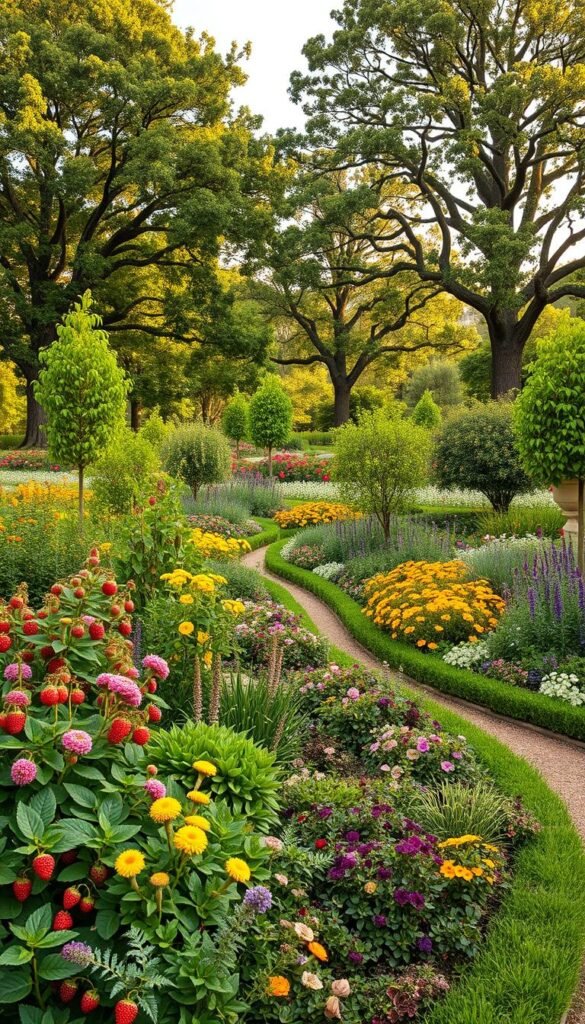Imagine stepping outside to an outdoor sanctuary where vibrant blooms mingle with juicy berries and fragrant herbs. This isn’t a fantasy—it’s the modern approach to designing spaces that nourish your senses while putting fresh food on your table.
Traditional yards often separate pretty flowers from practical crops. But why choose between aesthetics and productivity? Today’s trend focuses on blending colorful ornamentals with tasty plants, creating living art you can snack on. You’ll maximize every inch of your property while supporting local ecosystems.
Think dwarf apple trees framing rose bushes or blueberry shrubs doubling as privacy hedges. These combinations prove that edible elements can enhance visual interest without looking out of place. Even small patios can host container-grown citrus or trailing strawberries in hanging baskets.
This guide walks you through simple strategies to merge food-bearing plants into existing designs. Discover how textures, colors, and growth habits work together to build harmony. You’ll save time and resources by growing ingredients steps from your kitchen—all while boosting curb appeal.
Understanding the Edible Landscape Concept
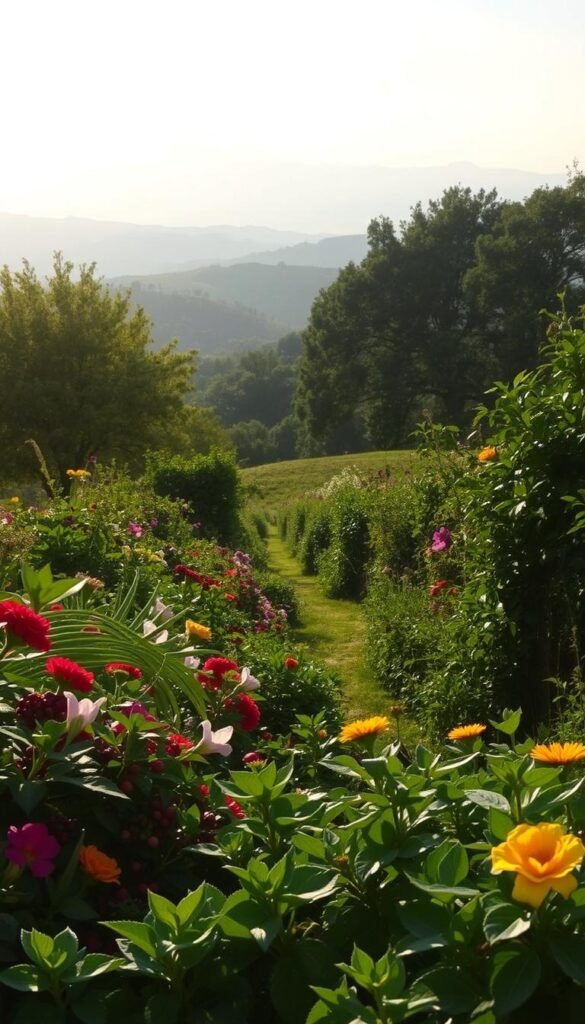
Picture a space where every plant serves dual purposes—delighting your eyes and feeding your family. This edible landscape approach transforms ordinary yards into living pantries bursting with color and flavor. No more relegating veggies to hidden corners or sacrificing style for sustainability.
Where Beauty Meets Bounty
Why settle for plain flower beds when rainbow chard can outshine petunias? Many edible plants rival traditional ornamentals in visual appeal. Purple basil’s glossy leaves complement marigolds, while strawberry runners create lush ground cover. Even fruit trees double as focal points when blooming.
Your Yard’s Hidden Superpowers
Multi-functional spaces offer more than fresh snacks. They:
- Cut grocery costs with homegrown herbs and veggies
- Attract pollinators with nectar-rich blooms
- Reduce food transportation emissions
Diverse plantings create resilient ecosystems. Birds snack on serviceberries instead of pests, while flowering thyme deters weeds. You’ll spend less time battling garden problems and more time enjoying your edible paradise.
Garden with Fruit Trees: Integrating Edibles into Flower Beds and Borders
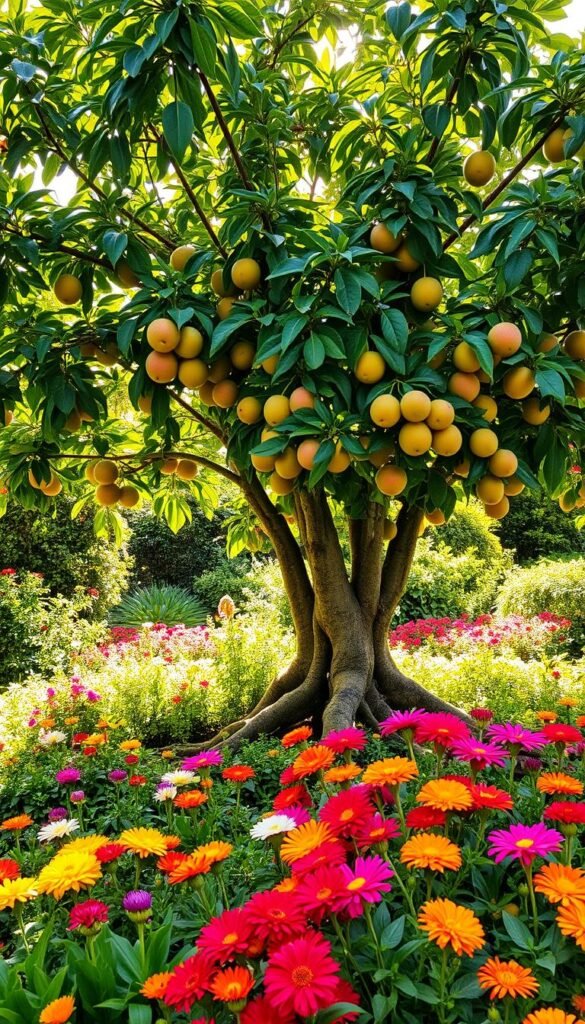
What if your landscape could feed both your senses and your pantry? Strategic placement of productive species transforms ordinary yards into layered ecosystems where every element pulls double duty.
Nature’s Perfect Partners
Taller varieties like dwarf apples or pears create instant structure in mixed borders. Their spring blossoms outshine most ornamentals, while autumn fruits add pops of color. Bonus: These living pillars support climbing edibles like grapes or kiwi vines.
Try tucking blueberry bushes between hydrangeas—their fall foliage matches perfectly. Raspberry canes thrive when paired with flowering shrubs that attract pollinators. This approach:
- Boosts biodiversity with varied root depths
- Provides natural pest control through companion planting
- Extends harvest seasons with staggered ripening
Smart placement creates microclimates too. A peach tree’s dappled shade protects tender lettuces, while its roots draw nutrients from deeper soil layers. You’ll get more flavor and yield without expanding your plot.
“The best gardens are those where form and function dance together—where every plant earns its keep.”
By thinking vertically, you maximize every square foot. Espaliered figs become living fences, while strawberry towers add whimsy to patio corners. Your space becomes a delicious puzzle where beauty and bounty interlock.
Designing Your Garden with Fruit Trees and Edible Elements
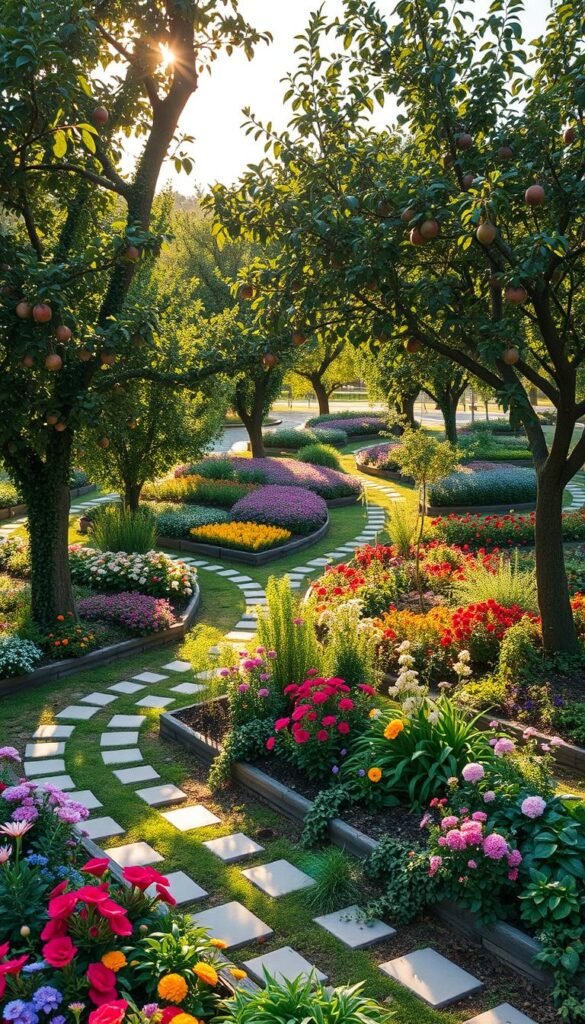
A well-planned edible landscape marries visual charm with practical harvests effortlessly. Start by sketching your area’s unique features—existing trees, pathways, and sunny patches. This blueprint becomes your roadmap for blending tasty specimens with decorative elements.
Mapping Out Your Productive Paradise
Grab graph paper and mark these key factors:
| Zone | Sun Exposure | Best Edibles |
|---|---|---|
| North Side | Partial Shade | Mint, Kale |
| South Edge | Full Sun | Peppers, Figs |
| East Border | Morning Light | Blueberries, Thyme |
Track sunlight patterns across seasons. That “full sun” summer spot might become shaded when deciduous trees lose leaves. Match each area’s conditions to plant needs for thriving growth.
Sunlight, Soil, and Smart Spacing
Test your ground’s pH and texture using affordable kits. Most edibles prefer slightly acidic soil (6.0-6.8 pH). Improve clay beds with compost, or build raised planters for better drainage.
| Soil Type | Modification | Ideal Plants |
|---|---|---|
| Sandy | Add organic matter | Carrots, Rosemary |
| Clay | Mix in gypsum | Brassicas, Grapes |
Leave breathing room between specimens—cramped roots battle for nutrients. Dwarf citrus needs 6-8 feet, while bush beans thrive in 4-inch gaps. Your landscape becomes both gallery and grocer when planned thoughtfully.
Creative Techniques for Planting and Arranging
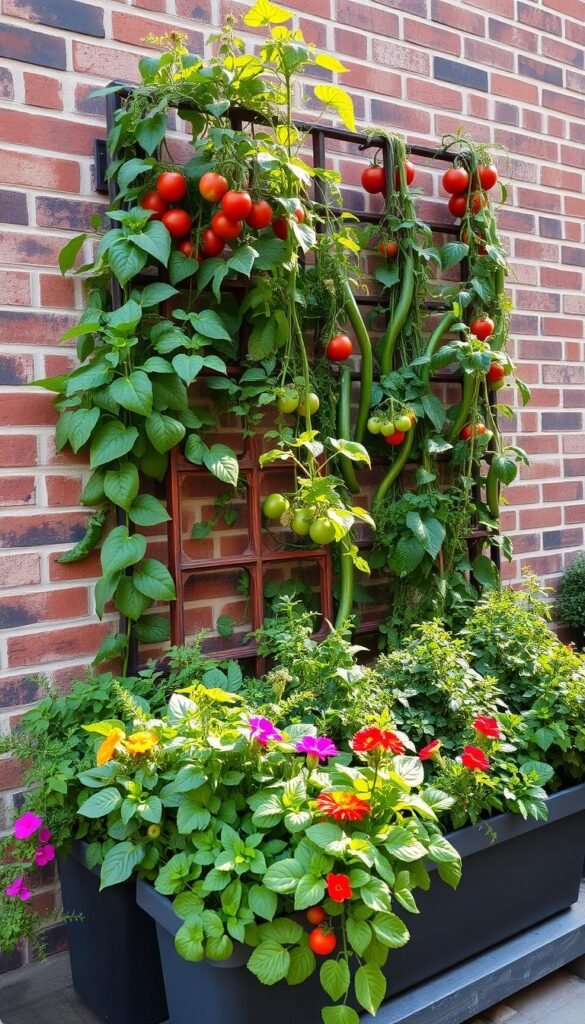
Turn blank walls into snack factories and transform patios into productive spaces. Smart planting strategies let you grow food in unexpected places while keeping your landscape stunning. Let’s explore two game-changing methods for tight areas.
Embracing Vertical Gardening and Container Options
Espaliered apple trees turn fences into living art galleries. Columnar varieties like Stark Scarlet Spire grow upward instead of outward, fitting neatly beside walkways. Try these space-saving ideas:
- Train grapevines on pergolas for shade + snacks
- Stack strawberry planters on sunny balconies
- Use hanging baskets for trailing raspberry canes
| Container Type | Ideal Size | Best Plants |
|---|---|---|
| Half Wine Barrel | 24″ diameter | Dwarf citrus, blueberries |
| Vertical Planter | 18″ depth | Strawberries, herbs |
| Fabric Grow Bag | 15 gallons | Figs, columnar apples |
Setting Up Mini Orchards and Companion Guilds
Group three semi-dwarf peach trees in a corner for instant orchard vibes. Surround them with clover (feeds soil) and chives (deters pests). This companion planting strategy creates self-sustaining ecosystems.
Living mulch systems work wonders too. Plant creeping thyme around pear trees—it suppresses weeds and adds purple blooms. Your edible landscape becomes a thriving community where every plant plays multiple roles.
Mixing Ornamentals with Edible Plants
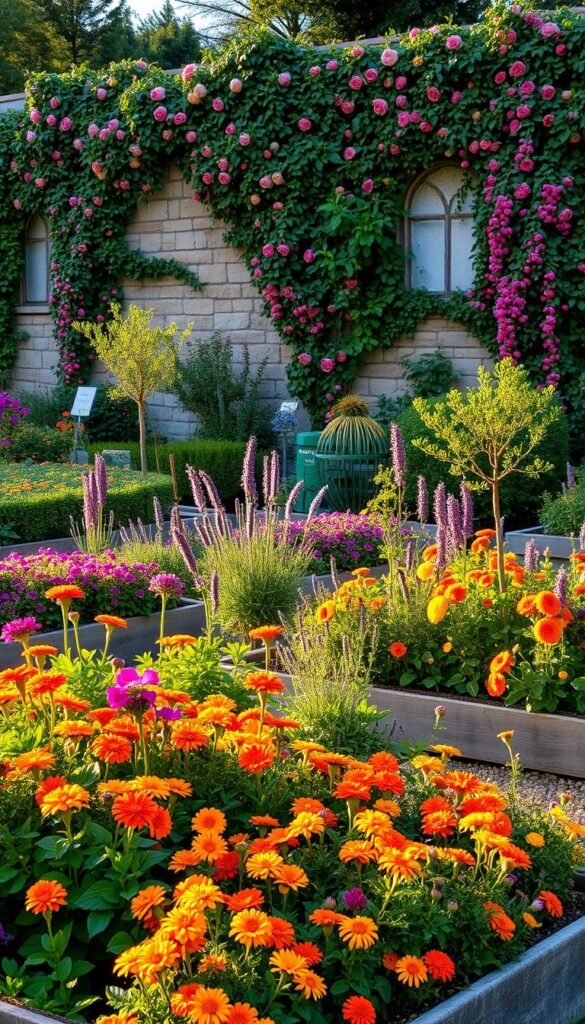
Who says your dinner can’t be as pretty as your petunias? Many edible species rival showy ornamentals in color and texture. The secret lies in pairing them thoughtfully to create visually appealing combinations that excite both eyes and taste buds.
Enhancing Visual Appeal with Flowers and Foliage
Swap ordinary shrubs with productive alternatives. Rainbow chard’s neon stems outshine coleus, while purple kale adds drama to borders. Try these eye-catching pairings:
- Nasturtiums spilling over retaining walls—their fiery blooms pop against stone
- Basil’s glossy leaves contrasting with feathery cosmos flowers
- Espaliered pear trees framing lavender hedges
Edible flowers pull double duty. Calendula petals brighten salads while attracting pollinators. Pansies create living confetti for cakes, and marigolds deter pests naturally. Pro tip: Plant borage near tomatoes—its star-shaped blue flowers boost yields.
Herb foliage offers unexpected textures. Silver sage mimics dusty miller’s sheen, while bronze fennel adds airy movement. Combine these with bold-leaved vegetables like cabbage for dynamic visual interest. A single rhubarb plant makes a striking centerpiece with its massive crimson stalks.
“When you design with edibles, every season brings new colors—spring’s strawberry blossoms, summer’s pepper rainbows, autumn’s persimmon fireworks.”
Create living mosaics by alternating red lettuces with white alyssum. Train scarlet runner beans up obelisks for vertical drama. Your landscape becomes a feast for all senses, proving productivity and beauty thrive together.
Plant Selection for Year-Round Interest
Transform your yard into a living calendar where every month brings new flavors and colors. Smart choices in fruit trees, herbs, and vegetables keep your space productive and picturesque across all seasons.
Choosing Fruit Trees, Berry Plants, and Herbs
Pick varieties that dazzle beyond harvest time. Blueberry bushes explode with white spring blooms before bearing summer berries, then blaze crimson in fall. Dwarf citrus trees offer fragrant flowers and glossy leaves alongside winter fruit.
| Plant Type | Seasonal Features | Top Picks |
|---|---|---|
| Fruit Trees | Spring blossoms, winter bark | Cherry, persimmon |
| Berries | Summer fruit, fall foliage | Raspberry, gooseberry |
| Herbs | Year-round texture | Rosemary, sage |
Incorporating Seasonal Colors and Textures
Rainbow chard’s neon stems shine from spring through frost. Pair purple kale with golden marigolds for contrast that lasts months. Strawberries work overtime—white spring flowers, red summer fruit, and evergreen leaves in mild winters.
Rotate cool-season lettuce and kale to fill gaps between harvests. Ornamental peppers keep their jewel-toned fruits into fall, while thyme’s tiny blooms attract pollinators until first frost. Your landscape becomes a kaleidoscope of edible artistry.
Celebrating Your Flourishing Edible Oasis
Your edible landscape becomes more than a source of fresh food—it’s a daily celebration of nature’s generosity. Each vibrant leaf and blooming stem nourishes both body and spirit, proving beauty and productivity thrive together. Start small: tuck basil between daylilies or plant dwarf blueberries near your patio. Success grows with every season.
This approach to landscaping invites life into your backyard. Clusters of herbs attract beneficial insects like butterflies and bees, turning your space into a thriving ecosystem. Even container gardens on balconies can host pollinator-friendly plants like thyme or dwarf sunflowers.
Notice how lemon balm’s scent lifts your mood while its flowers feed hungry pollinators. Watch children marvel at ladybugs patrolling strawberry leaves. These moments make your edible journey rewarding beyond harvest baskets.
Remember: there’s no perfect way to begin. Nurture a potted pear tree this year, add currant bushes next spring. Your yard evolves into a living tapestry where every plant serves multiple roles. With patience and curiosity, you’ll craft an oasis that delights senses, plates, and local wildlife alike.

